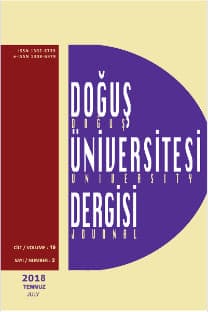Investigating the antecedents of organization identification
Türkiye
Örgütsel özdeşleşmenin öncülleri üzerine bir araştırma
Turkey,
___
- References ALBERT, S., & WHETTEN, D. (1985). Organizational identity. L.L. Cummings & B.M. Staw (Eds.), Research in Organizational Behavior, vol 7, pp.263-295.
- ALDER, S.G., NOEL T.W. & AMBROSE M.L. (2006). Clarifying the effects of Internet monitoring on job attitudes: The mediating role of employee trust, Information and Management, vol 43, pp. 894-903.
- ASHFORTH, B.E., & MAEL, F. (1989). Social identity theory and the organizations, Academy of Management Review, vol. 14, pp. 20-39.
- AYCAN, Z. (2001). Human resource management in Turkey - Current issues and future challenges, International Journal of Manpower, vol. 22:3, pp. 252-259.
- BALL, D.A., MCCULLOCH, W.H., FRANTZ, P.L., GERINGER, J.M., & MINOR, M.S. (2002). International Business: The Challenge of Global Competition, New York, NY, McGraw-Hill Irwin.
- BHATTACHARYA, C.B. & SEN, S. (2003). Consumer-company identification: A framework for understanding consumer’s relationship with companies, Journal of Marketing, 67:2, pp.76-88.
- BIES, R.J., & TRIP T.M. (1996). Beyond trust: “getting even” and the need for revenge. In R. M. Kramer & R.T. Tyler (Eds), Trust in Organizations: Frontiers of Theory and Research, Thousand Oaks: Sage Publications, London.
- BUTLER, J.K. (1991). Towards Understanding and Measuring Conditions of Trust; Evolution of a Conditions of Trust Inventory, Journal of Management, vol7, no. 3, pp. 643-63.
- COLE, M.S. and BRUCH, H. (2006). Organizational identity strength, identification, and commitment and their relationship with turnover intention: Does organizational hierarchy matter?. Journal of Organizational Behavior, vol 7, pp. 585-605.
- CONNAUGHTON, S.L., & DALY, J.A. (2004). Identification with leader, Corporate Communications: An International Journal, vol 9, no.2, pp. 89-103.
- COOK, J. & WALL, T (1980). New work attitude measures of trust, organizational commitment and personal need non-fulfillment, Journal of Occupational Psychology, vol 53, pp.39-52.
- CREMER, D.D., & VAN KNIPPENBERG, D. (2005). Cooperation as a function of leader self sacrifice, trust and identification, Leadership and Organizational Development Journal, vol 25, no.5, pp. 355-369.
- CUMMINGS, L.L. & BROMILEY, P. (1996). The Organizational trust inventory (OTI). In R. M. Kramer & T. R. Tyler (Eds.). Trust in Organizations. Thousand Oaks: Sage Publications, London.
- DE CREMER, D. VAN DIJKE, M. BOS A.E.R. (2006). Leader’s procedural justice affecting identification and trust, Leadership and Organization Development Journal, vol 27, no.7, pp. 554-565.
- DUKERICH, J.M., GOLDEN, B., & SHORTELl, S.M. (2002). Beauty is in the eye of the beholder: The impact of organizational identification, identity and image on physician cooperative behavior, Administrative Science Quarterly, vol 47,no.3, pp. 507-533.
- DUTTON, J., & DUKERICH, J. (1991). Keeping eye on the mirror: Image and identity in organizational adaptation, Academy of Management Journal, vol 34, pp. 517-554.
- DUTTON, J., & PENNER, J.W. (1993). The importance of organizational identity for strategic agenda building. In J. Hendry & G. Johnson (Eds.), Strategic Thinking: Leadership and the Management of Change, New York: Strategic Management Society, Wiley.
- DUTTON, J., DUKERICH, J., & HARQUAIL, C.V. (1994). Organizational images and membership commitment, Administrative Science Quarterly, vol 34, pp. 239-263.
- ELSBACH, K., & KRAMER, R.M. (1996). Member responses to organizational identity threats: Encountering and countering business week rankings, Administrative Science Quarterly, vol 41, pp. 442-476.
- HATCH, M. & SCHULTZ, M. (2002). The Dynamics Of Organizational Identity, Human Relations, vol 55, no.8, pp. 989-1005.
- HOSMER, L.T. (1995). Trust: The Connecting Link between Organization Theory Philosophical Ethics, Academy Of Management Review, vol 20, no.2, pp. 379- 403
- HUEMER, L. (2004). Balancing between stability and variety: Identity and trust trade-offs in networks, Industrial Marketing Management, vol 33, pp. 251-259.
- HUFF, L., & KELLEY, L. (2003). Levels of organizational trust in individualist versus collectivist societies: A seven nation study, Organization Science, Vol 14,no.1, pp. 81-91.
- JONES, G.R. & GEORGE, J.M. (1998). The experience and evolution of trust: Implications for cooperation and teamwork, Academy of Management Review, vol 23, no.3, pp. 531-546.
- JÖRESKOG, K.G. & SÖRBOM, D. (1993). LISREL : User’s reference Guide, Chicago: Scientific International Software.
- KRAMER, R.M. (1993). Cooperation and organizational identification. In J.K. Murnighan (Ed). Social Psychology in Organizations:. Englewood Cliffs, NJ: Prentice Hall, pp.144-1-269
- KREINER, G.E., & ASHFORTH, B.E. (2004). Evidence toward an expanded model of organizational identification, Journal of Organizational Behavior, vol 25, no.1, pp. 1-27.
- LEE, H. (2004). The role of competence based trust and organizational identification in continuous improvement, Journal of Managerial Psychology, vol 19, no.6, pp.623-639.
- MAEL, F., & ASHFORTH B.E. (1992). Alumni and their alma mater: A partial test of the reformulated model of organizational identification, Journal Of Organizational Behavior Vol 13, pp. 103-123.
- MAEL, F., & ASHFORTH B.E. (1995). Loyal from day one: Biodata organizational identification, and turnover among newcomers, Personnel Psychology, vol 48, pp. 309-333.
- MAYER, R., DAVIS, J.H., & SCHOORMAN, F.D. (1995). Integration model of organizational trust, Academy of Management Review, vol 20, no.3, pp. 709-734.
- MCALLISTER, D. (1995). Affect and cognition based trust as foundations for interpersonal cooperation in organization, Academy Of Management Journal, vol 38, no.1, pp. 24-59
- ISSN: 1302-6739
- Yayın Aralığı: 2
- Başlangıç: 2000
- Yayıncı: Doğuş Üniversitesi
İnternetin uluslararası ticaret üzerindeki etkileri : OECD ülkeleri örneği
SEYFETTİN ARTAN, CEMALETTİN KALAYCI
KİŞİSEL ve ÜRÜN TEMELLİ YENİLİKÇİLİK: CEP TELEFONU KULLANICILARI ÜZERİNE AMPİRİK BİR UYGULAMA
Yapısal kırılmalar altında Türkiye için işsizlik histerisinin sınanması
İMKB’DE SPEKÜLATİF ŞİŞKİNLERİN TEST EDİLMESİ
H. Mehmet TAŞÇI, H. Aydın OKUYAN
YAPISAL KIRILMALAR ALTINDA TÜRKİYE İÇİN İŞSİZLİK HİSTERİSİNİN SINANMASI
